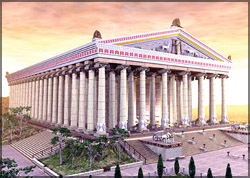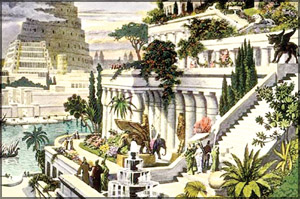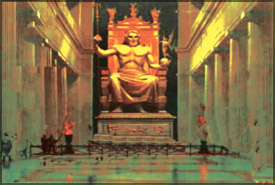|
Little Blue Birdie's diary
Ancient wonders of the world
Dear Diary,
Did you know that the new Seven Wonders
of the World were declared yesterday, July 7? So, I thought of writing
on the ancient wonders of the world. We can talk about the new list
later. The old wonders were all built between 3000 B.C. and 476 A.D. I
have already visited and written about the Pyramid of Giza, the only
remaining wonder from this list.
 The
historian Herodotus, and the scholar Callimachus of Cyrene (ca 305-240
BC) at the Museum of Alexandria had prepared early lists of "seven
wonders," but unfortunately, their writings have not survived, except as
references. The
historian Herodotus, and the scholar Callimachus of Cyrene (ca 305-240
BC) at the Museum of Alexandria had prepared early lists of "seven
wonders," but unfortunately, their writings have not survived, except as
references.
The earliest version of a list of seven wonders was compiled by
Antipater of Sidon, who described the structures in a poem around 140
BC. Today, I'll tell you about a few of these wonders. Wait for more in
the future issues.
Temple of Artemis at Ephesus
The Temple of Artemis had
been the most beautiful structure on Earth. It had been built in 550 BC
in honour of Artemis, the Greek goddess of hunting, nature, and
fertility.
This temple had been situated in the ancient city of Ephesus near the
modern town of Selcuk, about 50 km south of Izmir (Smyrna) in Turkey.
south of Izmir (Smyrna) in Turkey.
Although the foundation of the temple dates back to the seventh
century BC, the structure that earned a spot in the list of Wonders was
built around 550 BC. Referred to as the great marble temple, or Temple
D, it was sponsored by the Lydian king Croesus and was designed by the
Greek architect Chersiphron.
The Temple was decorated with bronze statues sculpted by the most
skilled artists of their time. The temple served as both a marketplace
and a religious institution.
On the night of July 21, 356 BC, a man named Herostratus burned the
temple to the ground in an attempt to immortalise his name, which he did
indeed. Alexander the Great was born the same night. The historians
later wrote that the goddess was "too busy taking care of the birth of
Alexander to send help to her threatened temple". The temple was
eventually restored and is labelled "Temple E" by archaeologists.
But, again, due to some religious battles, it was destroyed. Attempts
were recently made to rebuild the temple, but only a few columns have
been re-erected. The foundation of the temple was rectangular in form,
similar to most temples at the time. Unlike other sanctuaries, however,
the building was made of marble, with a decorated cover-up overlooking a
spacious courtyard.
Marble steps surrounding the building platform led to the high
terrace which was 80 m (260 ft) by 130 m (430 ft) in plan. The columns
were 20 m (60 ft) high with Ionic capitals and carved circular sides.
There were 127 columns in total, aligned orthogonally (right angled)
over the whole platform area, except for the central cellar or house of
the goddess.
The temple housed many works of art, including four ancient bronze
statues of Amazons sculpted by the finest artists at the time. The
temple was said to be adorned with golden pillars and silver statuettes,
and was decorated with paintings.
There is no evidence that a statue of the goddess herself was placed
at the centre of the sanctuary, but there is no reason not to believe
so. The early detailed descriptions of the temple helped archaeologists
reconstruct the building.
****
Hanging Gardens of Babylon
This was known to be
located on the east bank of the River Euphrates, about 50 km south of
Baghdad, Iraq. It was said to be constructed in 600 B.C. and had been
destructed after the first century B.C. in an earthquake.
Nebuchadnezzar II (604-562 BC), of the Mesopotamian civilization, is
credited with the building of the legendary Hanging Gardens. It is said that the Gardens were built by
Nebuchadnezzar to please his wife or partner, who had been brought up in
Media and had a passion for mountain surroundings.
Hanging Gardens. It is said that the Gardens were built by
Nebuchadnezzar to please his wife or partner, who had been brought up in
Media and had a passion for mountain surroundings.
It wasn't until the twentieth century that some of the mysteries
surrounding the Hanging Gardens were revealed. Archaeologists are still
struggling to gather enough evidence before reaching final conclusions
about the location of the Gardens, their irrigation system, and their
true appearance.
Some recent researchers even suggest that the Hanging Gardens were
built by Senaherib, not by Nebuchadnezzar II (ca. 100 years
earlier).Detailed descriptions of the Gardens come from ancient Greek
sources, including the writings of Strabo and Philo of Byzantium.
More recent archaeological excavations at the ancient city of Babylon
in Iraq uncovered the foundation of the palace. Other findings include
the Vaulted Building with thick walls and an irrigation well near the
southern palace. A group of archaeologists surveyed the area of the
southern palace and reconstructed the vaulted building as the Hanging
Gardens.
However, the Greek historian Strabo had stated that the gardens were
situated by the River Euphrates. Some argue that the site is too far
from the Euphrates to support the theory since the Vaulted Building is
several metres away.
They reconstructed the site of the palace and located the Gardens in
the area stretching from the river to the palace. On the river banks,
recently discovered massive walls (25 m thick) may have formed
terraces... the ones described in Greek references.
***
Statue of Zeus in Olympia
This is the statue of the
god in whose honour the Ancient Olympic Games were held. It was located
on the land that gave its very name to the Olympics, the ancient town of Olympia, on
the west coast of modern Greece, about 150 km west of Athens.
that gave its very name to the Olympics, the ancient town of Olympia, on
the west coast of modern Greece, about 150 km west of Athens.
This was constructed in 435 B.C. and was destructed in 5th-6th
centuries A.D. from a fire. The magnificent temple of Zeus was designed
by the architect Libon and was built around 450 BC.
Under the growing power of ancient Greece, the simple Doric-style
temple seemed too dull, and modifications were needed. As a solution, a
majestic statue had been built. In the second century BC, repairs were
expertly made to the ageing statue.
The base of the statue was about 6.5 m (20 ft) wide and one metre
(three feet) high. The height of the statue itself was 13 m (40 ft),
equivalent to a modern four-storey building. The statue was so high that
visitors described the throne more than Zeus' body and features. |
